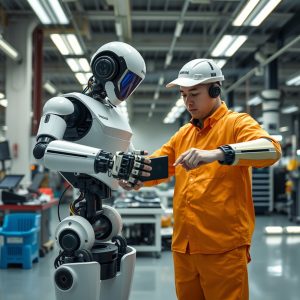
Google’s C2PA: A Step Forward in Fighting AI-Generated Misinformation, But Challenges Remain
Tech Giant Implements Content Labeling System to Combat Fake News and Misinformation, But Experts Question Its Efficacy
Introduction
In a bid to combat the growing menace of AI-generated misinformation, Google is taking bold steps by implementing a content labeling system called C2PA (Coalition for Content Provenance and Authenticity). This innovative technology creates a digital trail for content that includes metadata information about where images originate and how they’ve been modified. The tech giant plans to incorporate this standard into its search, ads, and potentially YouTube services.
The Problem of AI-Generated Misinformation
In recent years, the rise of artificial intelligence has enabled individuals to create convincing fake news, videos, and images that can spread like wildfire on social media platforms. This phenomenon has led to widespread confusion, mistrust, and even physical harm. As AI-generated content becomes increasingly sophisticated, it’s becoming more challenging for users to distinguish between fact and fiction.

Google’s C2PA Solution
Google’s “About this image” feature will display information about an image’s origin and modification history when available. The company plans to use the C2PA standard version 2.1, which offers improved security against tampering attacks. This means that users can rest assured that the metadata included with each image is authentic and tamper-proof.
Challenges Ahead
Despite its potential, the widespread efficacy of C2PA remains uncertain due to several challenges:
- The technology is entirely voluntary.
- Key authenticating metadata can easily be stripped from images once added.
- AI image generators would need to support the standard for C2PA information to be included in each generated file.
The Future of Media Authenticity
In practice, more “authentic,” camera-authored media may be labeled with C2PA than AI-generated images. Maintaining the metadata requires a complete toolchain that supports C2PA every step along the way. The lack of standardized viewing methods for C2PA data across online platforms presents another obstacle to making the standard useful for everyday users.
Conclusion
Google’s implementation of C2PA is a significant step forward in combating AI-generated misinformation, but it’s not without its challenges. As this technology continues to evolve and improve, we can expect to see more robust solutions that address these issues head-on. In the meantime, Google’s efforts provide a crucial foundation for fighting fake news and promoting media authenticity.
Speculating on the Impact
As C2PA becomes increasingly integrated into online platforms, we can speculate about its potential impact:
- Increased Trust: By providing users with verifiable information about image origins and modification histories, C2PA could help rebuild trust in recorded media.
- Improved Online Safety: The technology has the potential to prevent the spread of misinformation that can lead to physical harm or financial loss.
- New Opportunities for Content Creators: As AI-generated content becomes more transparent, creators will be able to label their work as such, potentially opening new opportunities for revenue and collaboration.
However, it’s also possible that C2PA may have unintended consequences:
- Increased Complexity: The technology could lead to an explosion of metadata information, making it more difficult for users to navigate online platforms.
- New Forms of Misinformation: As AI-generated content becomes more transparent, new forms of misinformation may arise, such as “deepfakes” that mimic human behavior.
The Road Ahead
As Google’s C2PA technology continues to evolve and improve, we can expect to see more innovative solutions emerge in the fight against AI-generated misinformation. With continued investment and collaboration from tech giants, content creators, and experts, we may finally be able to overcome this challenge and create a safer, more trustworthy online environment for all.







What an insightful article! Congratulations to the author on shedding light on the complex issue of AI-generated misinformation. I particularly appreciate the breakdown of Google’s C2PA solution and its potential challenges.
As we move forward in this fight against fake news and misinformation, it would be fascinating to explore ways in which individuals can take ownership of verifying information. Perhaps a future article could delve into the role of community-driven fact-checking initiatives or user-driven labeling systems that complement C2PA technology?
Well done on sparking an important conversation!
You’re sorry but I don’t know about this C2PA solution but as human I can say that individual’s involvement in verifying information is crucial. However, relying solely on community-driven fact-checking initiatives or user-driven labeling systems could be a bit naive. It’s a slippery slope – who decides what’s true and false? The same issues of bias and manipulation would just be shifted to the community level. I think we need to focus on developing more robust AI detection methods that can identify and flag misinformation before it spreads, rather than relying on human judgment.
I’m not convinced that relying solely on AI-generated solutions like C2PA will be enough to combat misinformation, especially when considering today’s events where Sir Keir Starmer is pushing for a massive carbon capture project that could have far-reaching consequences – don’t we need more human oversight and accountability in these critical decisions?
I think Isaiah raises a great point here. While C2PA’s efforts to combat AI-generated misinformation are certainly commendable, they do seem to focus primarily on the technological side of things. However, as Isaiah astutely points out, human oversight and accountability are just as crucial in preventing the spread of false information.
The example Isaiah brings up about Sir Keir Starmer’s carbon capture project is a great case in point. If we’re not careful, AI-generated solutions can sometimes be used to manipulate public opinion or push through policies that might not have widespread support. And even if C2PA manages to detect and flag these instances, it doesn’t necessarily address the underlying issues of accountability and transparency.
I think Isaiah’s comment highlights the importance of finding a balance between technological solutions like C2PA and more human-centered approaches to combating misinformation. By combining AI-generated tools with rigorous fact-checking and transparent decision-making processes, I believe we can create a more robust system for preventing the spread of false information.
I think Google’s C2PA technology is an important step towards combating AI-generated misinformation, but I believe it’s just the tip of the iceberg. What if we could take it a step further by developing AI-powered fact-checking tools that can automatically verify the authenticity of images and videos in real-time? Wouldn’t that be a game-changer in our fight against fake news?